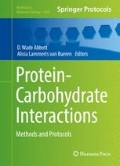Abstract
Fluorophore-assisted carbohydrate electrophoresis (FACE) is a method in which a fluorophore is covalently attached to the reducing end of carbohydrates, thereby allowing visualization following high-resolution separation by electrophoresis. This method can be used for carbohydrate profiling and sequencing, as well as for the determination of the specificity of carbohydrate-active enzymes. Here, we describe and demonstrate the use of FACE to separate and visualize the glycans released following digestion of oligosaccharides by glycoside hydrolases (GHs) using two examples: (1) the digestion of chitobiose by the streptococcal β-hexosaminidase GH20C, and (2) the digestion of glycogen by the GH13 member SpuA.
Access this chapter
Tax calculation will be finalised at checkout
Purchases are for personal use only
References
Jackson P (1993) Fluorophore-assisted carbohydrate electrophoresis: a new technology for the analysis of glycans. Biochem Soc Trans 21:121–125
Jackson P (1990) The use of polyacrylamide-gel electrophoresis for the high-resolution separation of reducing saccharides labelled with the fluorophore 8-aminonaphthalene-1,3,6-trisulphonic acid. Detection of picomolar quantities by an imaging system based on a cooled cha. Biochem J 270:705–713
Jackson P (1996) The analysis of fluorophore-labeled carbohydrates by polyacrylamide gel electrophoresis. Mol Biotechnol 5:101–123
Calabro A, Midura R, Wang A et al (2001) Fluorophore-assisted carbohydrate electrophoresis (FACE) of glycosaminoglycans. Osteoarthritis Cartilage 9:16–22
Gao N (2005) Fluorophore-assisted carbohydrate electrophoresis: a sensitive and accurate method for the direct analysis of dolichol pyrophosphate-linked oligosaccharides in cell cultures and tissues. Methods 35:323–327
Morell MK, Samuel MS, O’Shea MG (1998) Analysis of starch structure using fluorophore-assisted carbohydrate electrophoresis. Electrophoresis 19:2603–2611
Starr CM, Masada RI, Hague C et al (1996) Fluorophore-assisted carbohydrate electrophoresis in the separation, analysis, and sequencing of carbohydrates. J Chromatogr A 720:295–321
Young KD (1996) A simple gel electrophoretic method for analyzing the muropeptide composition of bacterial peptidoglycan. J Bacteriol 178:3962–3966
Cordes EH, Jencks WP (1962) On the mechanism of schiff base formation and hydrolysis. J Am Chem Soc 84:832–837
Kooy FK, Ma M, Beeftink HH et al (2009) Quantification and characterization of enzymatically produced hyaluronan with fluorophore-assisted carbohydrate electrophoresis. Anal Biochem 384:329–336
Frado LY, Strickler JE (2000) Structural characterization of oligosaccharides in recombinant soluble human interferon receptor 2 using fluorophore-assisted carbohydrate electrophoresis. Electrophoresis 21:2296–2308
Boraston AB, Sandercock LE, Warren RAJ, Kilburn DG (2003) O-glycosylation of a recombinant carbohydrate binding module mutant secreted by Pichia pastoris. J Mol Microbiol Biotechnol 5:29–36
Bardor M, Cabanes-Macheteau M, Faye L, Lerouge P (2000) Monitoring the N-glycosylation of plant glycoproteins by fluorophore-assisted carbohydrate electrophoresis. Electrophoresis 21:2550–2556
Basu SS, Dastgheibhosseini S, Hoover G et al (1994) Analysis of glycosphingolipids by fluorophore-assisted carbohydrate electrophoresis using ceramide glycanase from Mercenaria mercenaria. Anal Biochem 222:270–274
De Rezende CE, Anriany Y, Carr LE et al (2005) Capsular polysaccharide surrounds smooth and rugose types of salmonella enterica serovar typhimurium DT104 capsular polysaccharide surrounds smooth and rugose types of salmonella enterica serovar typhimurium DT104. Appl Environ Microbiol 71:7245
Oonuki Y, Yoshida Y, Uchiyama Y, Asari A (2005) Application of fluorophore-assisted carbohydrate electrophoresis to analysis of disaccharides and oligosaccharides derived from glycosaminoglycans. Anal Biochem 343:212–222
Abbott DW, Higgins MA, Hyrnuik S et al (2010) The molecular basis of glycogen breakdown and transport in streptococcus pneumoniae. Mol Microbiol 77:183–199
Gregg KJ, Zandberg WF, Hehemann J-H et al (2011) Analysis of a new family of widely distributed metal-independent alpha-mannosidases provides unique insight into the processing of N-linked glycans. J Biol Chem 286:15586–15596
Hehemann J-H, Kelly AG, Pudlo NA et al (2012) Bacteria of the human gut microbiome catabolize red seaweed glycans with carbohydrate-active enzyme updates from extrinsic microbes. Proc Natl Acad Sci U S A 109:19786–19791
Robb M, Robb CS, Higgins MA et al (2015) A second β-hexosaminidase encoded in the streptococcus pneumoniae genome provides an expanded biochemical ability to degrade host glycans. J Biol Chem 290:30888–30900
Acknowledgments
This work has been supported by the Canadian Institute of Health Research operating grant MOP 130305.
Author information
Authors and Affiliations
Corresponding author
Editor information
Editors and Affiliations
Rights and permissions
Copyright information
© 2017 Springer Science+Business Media LLC
About this protocol
Cite this protocol
Robb, M., Hobbs, J.K., Boraston, A.B. (2017). Separation and Visualization of Glycans by Fluorophore-Assisted Carbohydrate Electrophoresis. In: Abbott, D., Lammerts van Bueren, A. (eds) Protein-Carbohydrate Interactions. Methods in Molecular Biology, vol 1588. Humana Press, New York, NY. https://doi.org/10.1007/978-1-4939-6899-2_17
Download citation
DOI: https://doi.org/10.1007/978-1-4939-6899-2_17
Published:
Publisher Name: Humana Press, New York, NY
Print ISBN: 978-1-4939-6898-5
Online ISBN: 978-1-4939-6899-2
eBook Packages: Springer Protocols

